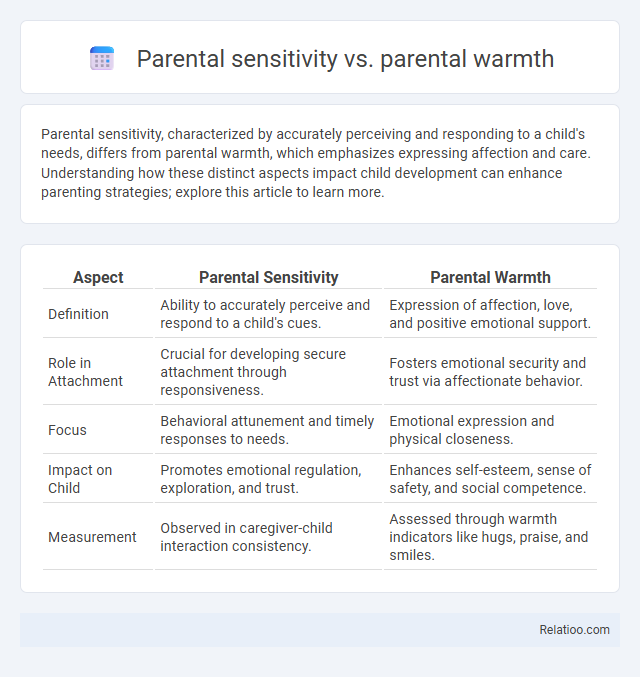Parental sensitivity, characterized by accurately perceiving and responding to a child's needs, differs from parental warmth, which emphasizes expressing affection and care. Understanding how these distinct aspects impact child development can enhance parenting strategies; explore this article to learn more.
Table of Comparison
| Aspect | Parental Sensitivity | Parental Warmth |
|---|---|---|
| Definition | Ability to accurately perceive and respond to a child's cues. | Expression of affection, love, and positive emotional support. |
| Role in Attachment | Crucial for developing secure attachment through responsiveness. | Fosters emotional security and trust via affectionate behavior. |
| Focus | Behavioral attunement and timely responses to needs. | Emotional expression and physical closeness. |
| Impact on Child | Promotes emotional regulation, exploration, and trust. | Enhances self-esteem, sense of safety, and social competence. |
| Measurement | Observed in caregiver-child interaction consistency. | Assessed through warmth indicators like hugs, praise, and smiles. |
Understanding Parental Sensitivity
Parental sensitivity involves accurately perceiving and interpreting Your child's cues and responding promptly and appropriately to their needs, which enhances emotional security and attachment. Parental warmth refers to the expression of affection, support, and positive regard, fostering a nurturing and loving environment. Understanding parental sensitivity is key to promoting healthy child development, as it directly impacts Your child's emotional regulation and social competence.
Defining Parental Warmth
Parental warmth encompasses behaviors such as affection, support, and positive reinforcement that create a nurturing environment for Your child's emotional development. Unlike parental sensitivity, which involves accurately perceiving and responding to a child's cues, warmth focuses more on expressing love and encouragement. Both parental sensitivity and warmth are crucial, but warmth specifically strengthens emotional bonds and fosters secure attachments.
Key Differences Between Sensitivity and Warmth
Parental sensitivity refers to a caregiver's ability to perceive and accurately respond to a child's needs and signals, ensuring appropriate emotional support and guidance. Parental warmth emphasizes affectionate behaviors like hugging, praise, and nurturing to create a secure and loving environment. Understanding these key differences helps you tailor your parenting approach to balance responsiveness with emotional closeness, fostering optimal child development.
Impact of Parental Sensitivity on Child Development
Parental sensitivity involves accurately perceiving and responding to your child's cues, which significantly enhances emotional security and social competence in early childhood. Unlike parental warmth, which emphasizes affection and positive regard, sensitivity fosters better cognitive and emotional development by adapting to the child's unique needs and signals. Research consistently shows that high parental sensitivity leads to improved attachment quality, reducing behavioral problems and promoting resilience in your child's overall development.
Influence of Parental Warmth on Emotional Well-being
Parental warmth significantly influences your child's emotional well-being by fostering secure attachment and promoting positive self-esteem. Unlike parental sensitivity, which involves accurately perceiving and responding to a child's cues, warmth emphasizes consistent expressions of affection and support, creating a nurturing environment. This emotional connection reduces the risk of anxiety and depression in children, underscoring the vital role of warmth in healthy emotional development.
Cultural Perspectives on Parenting Styles
Parental sensitivity emphasizes recognizing and responding appropriately to a child's needs, while parental warmth reflects overt affection and support; cultural perspectives shape how these behaviors are expressed and valued in different societies. In collectivist cultures, parental sensitivity may prioritize group harmony and obedience, whereas in individualist cultures, warmth is often demonstrated through verbal praise and emotional openness. Understanding these cultural nuances is crucial for interpreting parenting styles and their impact on child development across diverse populations.
Measuring Sensitivity and Warmth in Parenting
Measuring parental sensitivity involves observing a caregiver's ability to accurately perceive and respond to a child's cues, often assessed through structured interaction tasks and coding systems like the Emotional Availability Scales. Parental warmth is typically quantified by evaluating affectionate behaviors, verbal expressions of love, and positive reinforcement, using tools such as self-report questionnaires and direct behavioral observations. Comparing these measures highlights that sensitivity captures responsiveness to a child's needs, while warmth emphasizes expressions of affection, both crucial for child development assessments.
Parental Sensitivity vs Warmth: Which Matters More?
Parental sensitivity, defined as a caregiver's ability to accurately perceive and respond to a child's cues, plays a crucial role in fostering secure attachment and emotional regulation, often having a more direct impact on child development than parental warmth, which reflects the general expression of affection and positive regard. Studies emphasize that while parental warmth creates a nurturing environment, sensitivity drives the quality of parent-child interactions by tailoring responses to the child's individual needs, enhancing cognitive and socio-emotional outcomes. The nuanced attentiveness characterizing parental sensitivity often predicts better developmental trajectories compared to warmth alone, highlighting its primacy in effective parenting strategies.
Strategies to Enhance Parental Sensitivity and Warmth
Parental sensitivity involves accurately perceiving and responding to your child's signals, while parental warmth reflects the expressions of affection and support you provide consistently. Strategies to enhance both include actively observing your child's cues, offering consistent emotional support, and engaging in responsive communication that fosters trust and emotional security. Practicing mindfulness and empathy helps you attune to your child's needs, strengthening your relationship and promoting their emotional well-being.
Long-term Outcomes of Sensitive and Warm Parenting
Parental sensitivity, characterized by accurately perceiving and responding to your child's cues, fosters secure attachment and emotional regulation, leading to better social competence and academic success in the long term. Parental warmth involves expressing affection and support, promoting resilience, self-esteem, and positive peer relationships that persist into adulthood. Combining sensitivity and warmth enhances your child's cognitive development and psychological well-being, decreasing the risk of behavioral problems and mental health issues over time.

Infographic: Parental sensitivity vs Parental warmth
 relatioo.com
relatioo.com